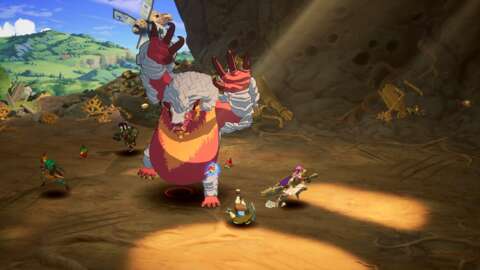Towerborne is a pretty drastic departure from the Banner Saga series, developer Stoic Studio’s impressive set of story-driven strategy games. But even with just a short look at it, it’s easy to see some of the familiar Stoic DNA in Towerborne. It carries a beautiful art style that recalls a hand-drawn aesthetic, similar to Banner Saga, and that gives it a powerful vibrancy.
I played a short demo of Towerborne at Xbox’s recent Gamescom event in Los Angeles, which gave a very quick look at its moment-to-moment combat gameplay. Towerborne is a side-scrolling co-op action-RPG that takes its inspiration from beat-em-ups. There’s clearly a lot of inspiration being drawn from old-school arcade entries in the genre, but Towerborne separates itself through a combat system that includes a variety of combos and special moves, offering something a little deeper than just mashing buttons.
First, Towerborne lets you adjust your fighting style based on the weapons your character uses, and from the sound of things, you can change those weapons frequently to give yourself new options. I teamed up with another journalist to run through the demo, starting with a character who dual-wielded daggers. The fighting style for that character was pretty fast and frenetic, slashing away at close range and mixing in kicks for heavy attacks.
Each character has access to light and heavy standard attacks, which can be linked together to create combos that trigger different attack animations. For instance, I could cut up opponents with my daggers using light attacks, or fire off a heavy combo with a series of kicks, but linking them together triggered a new set of combos in which I could kick some enemies up in the air.
The combo ability was even more notable for the second character in the build who carried a heavy club with two hands. The blunt end of the club contained something like a furnace that could be used to belch flame and set enemies on fire with certain attacks. Light attacks jabbed with the staff end of the club, while slower heavy attacks swung the club around for big damage. The combination of light and heavy, however, caused the character to take a knee and start using the club like a shotgun, belching flame and setting enemies ablaze. In addition to the damage done by the attack, the flaming enemies also burned for a short period, demonstrating that your weapons and their abilities can have a lot of different uses against enemies.
In addition to standard attacks, you charge up special abilities that are specific to your weapons, all of which run on cooldown timers. My dagger character had a special ability that allowed her to throw a knife at an enemy and then teleport to its location to start an attack, making it easy to cross the battlefield and kick off a fight. I could also throw a series of daggers ahead of me for big damage against a single target, or leap into the air and throw daggers downward, with the knives lingering in the ground to hurt opponents who walked across them. The strongest attack in my arsenal was a magic area-of-effect attack that would cause a massive explosion after a short period. Leaving the trap behind was great to catch small enemies as they charged toward us.
Weapon choices seem to drastically change how a character fights in Towerborne.
The club character had some similar moves, one which caused him to spin around like a top and slam enemies with the club for extended damage, and another that had him leaping in the air and blasting the ground with flame to create a damaging effect. Instead of a magic explosion, his AOE attack caused the ground ahead of him to erupt in a straight line.
The demo’s level was a short one, with the two of us working our way across grasslands, fighting off enemies like moles and bandits on our way from right to left. Occasionally, we’d fight off multiple waves that would keep coming, requiring us to smash up an enemy spawn point like a tent. It’s fairly standard beat-em-up stuff, but with the variety of moves Towerborne offers in combat, alongside a dodge quickstep and a roll, the game takes on more of a feeling of an ARPG played from a side-scrolling viewpoint. And like in an ARPG, the combat loop in Towerborne puts a big focus on finding the right times to maximize the effectiveness of your abilities and managing their cooldowns.
The final moment of the demo culminated in a big boss fight with Pangojira, a huge pangolin creature flanked by a bunch of smaller burrowing monsters. With the two of us, we naturally gravitated toward dividing the labor of the fight–focusing on the boss when possible, and splitting up to take out the smaller enemies as they appeared. If we were quick, we could stop the smaller enemies from attacking at all by hitting them as they were burrowing out of the ground, knocking them out in one hit. That became an important way to manage their numbers, as the game would throw what felt like 30 pangolins at us at a time. In addition to the boss, it could be tough to manage, especially because each pangolin could weather a pretty significant beating before dying.
The boss itself rolled out the kinds of attacks you might expect to see in a beat-em-up like this. It would jump around the arena, sending shockwaves across the ground that we needed to jump over, or throw rocks into the air that would fall all around the battlefield and force us to dodge away. It attacked pretty frequently, too, which meant that it was important for us to get our hits in as fast as possible before getting clear of its very long reach. Towerborne punishes you if you’re not paying attention–big hits will send you flying, leaving you stunned on the ground for a while.
Pangojira will absolutely clobber you if you’re not paying attention.
Movement is a bit clunky and slow, too, which means that you can’t rely on just running and dodging to get around enemy attacks; instead, you have to watch your opponents, understand how they move, and anticipate their biggest and fastest blows so that you have enough time to get clear of them.
If we hit the pangolin boss hard enough, however, we could stun it for a bit, allowing us to deal massive damage with all our abilities. The pyroclast could also use its abilities to set the boss on fire for a little extra chip damage, as well. We tended to divide our labor between me, with my daggers, cleaning up the little guys, while my partner laid into the boss with his harder-hitting moves. There were a few points where the fight got a little hairy–take too much damage and, like in most games, you’ll drop to your knees, requiring either a teammate to revive, or burning what seemed to be a spare life to revive yourself. For the most part, though, smart use of our special moves was enough to keep the arena clear of enemies while we whittled down the boss’s health to finish it off.
Our look at Towerborne was pretty brief, focusing only on moment-to-moment combat. We know Towerborne has a lot of live-game systems, is heavily focused on chasing loot, and has a very Destiny-like feel for a lot of its systems–Bungie alumni are among the development team and a few of the choices that evoke the decade-old MMO.
What we saw, though, has promise. It took a bit to get used to the game, especially in its movement and dodge systems, which are slower than you might expect and thus aren’t conducive to twitchy, reactive play, instead requiring you to be more deliberate about how you engage enemies. But that’s also in keeping with the arcade beat-em-ups of the ’90s that Stoic is riffing on, and the ARPG additions to the gameplay like lots of special moves, alongside deploying interesting combos you can use to exploit enemy weaknesses, feel like smart updates to classic gameplay, at least in our short look at it.
Towerborne is set to release on PC, Xbox Series X|S, and Xbox Game Pass on September 10.


